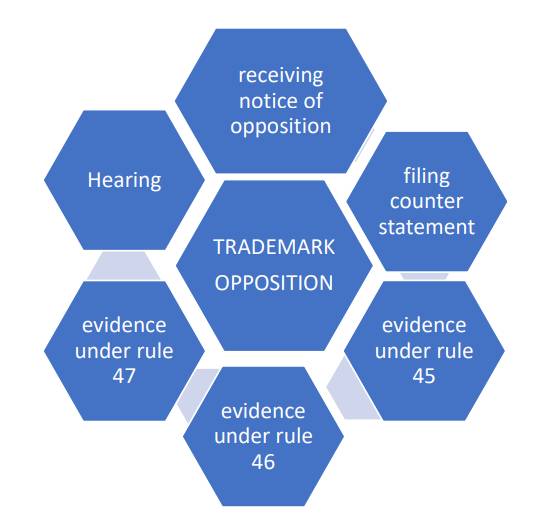Trademark Opposition
A trademark is a recognizable sign, design, expression, or symbol that identifies products or services of a particular source from those of others. It can be a word, phrase, symbol, or design, or a combination of these elements. Trademarks help consumers identify and distinguish between goods or services in the marketplace, thus protecting the brand identity and reputation of the products or services associated with the trademark.
Trademark rights are typically obtained through registration with the appropriate government authority, such as the United States Patent and Trademark Office (USPTO) in the United States or the European Union Intellectual Property Office (EUIPO) in the European Union. However, in some jurisdictions, rights can also be established through use of the mark in commerce, known as common law trademark rights.
Trademark registration provides the owner with exclusive rights to use the mark in connection with the goods or services covered by the registration. It also gives the owner the right to prevent others from using similar marks in a way that could cause confusion among consumers.
Trademark law aims to prevent consumer confusion and protect the goodwill associated with a particular brand. It also provides legal remedies, such as injunctions and damages, for infringement of trademark rights. Trademarks are important assets for businesses, as they can add significant value to a company's brand and contribute to its success in the marketplace.
TRADEMARK OPPOSITION
Trademark opposition is a legal proceeding that occurs after a trademark application has been filed but before it is officially registered. During this phase, third parties who believe they may be harmed by the registration of the trademark can file a notice of opposition with the relevant trademark office. The opposition typically outlines the grounds for why the trademark should not be registered, such as the likelihood of confusion with an existing trademark, the genericness of the proposed mark, or other legal reasons.
Once an opposition is filed, the trademark applicant has an opportunity to file counter statement within 30 days from the date of receiving opposition from another party, and the matter may proceed to a formal opposition proceeding. This process resembles a trial, where evidence and arguments are presented by both sides, and a decision is made by the trademark office or a trademark trial and appeal board.
The goal of trademark opposition proceedings is to ensure that only valid trademarks are registered, thereby protecting consumers from confusion and preventing unfair competition among businesses. It allows interested parties to challenge potentially problematic trademark registrations before they become official.
GROUNDS OF OPPOSITION
Trademarks may be opposed for various specific reasons. Here, we present the most common reasons for opposition:
- The proposed trademark bears resemblance to an existing trademark and may lead to a likelihood of consumer confusion. This is commonly cited as the primary reason for a trademark opposition.
- A widely recognized trademark might undergo dilution if an application is sanctioned.
- An individual is endeavoring to trademark a family name.
- A sought-after trademark is either generic or merely a descriptive term.
- An approved trademark could imply a false association, sponsorship, or origin.
TRADEMARK OPPOSITION PERIOD
For various reasons, it is strongly recommended to file a trademark opposition at the earliest opportunity. In case a serious issue arises that prevents filing within the initial 30-day timeframe, it is possible to request an extension of time. However, it is crucial that the extension request be submitted before the 30-day opposition period expires.
WHO CAN OPPOSE
Any aggrieved party who feels that their mark is being infringed upon by another applicant and who anticipates potential future losses as a result or any individual or entity with legal standing, who believes that their rights may be affected by the registration of a particular trademark, has the authority to file opposition against it.
WHAT IS COUNTER STATEMENT?
A counterstatement against trademark opposition is a formal response filed by the applicant of a trademark in response to an opposition filed by another party. When a trademark application is opposed by a third party, the applicant is given an opportunity to respond to the opposition by submitting a counterstatement.
In the counterstatement, the applicant typically addresses the grounds for opposition raised by the opposing party. This may involve providing arguments and evidence to refute the claims made by the opponent and to support the registration of the trademark. The counterstatement is an important step in the trademark opposition process as it allows the applicant to defend their trademark application and to continue the registration process.
he specifics of the counterstatement process may vary depending on the jurisdiction and the rules of the trademark office handling the opposition proceedings. However, in general, the counterstatement provides the applicant with a formal mechanism to respond to the opposition and to present their case for why the trademark should be registered despite the objections raised by the opposing party.
STEPS AND TIMELINE OF FILINGS UNDER TRADEMARK OPPOSITION IN INDIA

STEP 1 NOTICE OF OPPOSITION
The notice of opposition must be submitted within 4 months from the date of publication of the trademark in the trademark journal. Once the status is accepted and the trademark is advertised, any person wishing to file a notice of opposition against our applied mark must do so within 4 months from the date on which the applied mark is accepted for advertisement
STEP 2 COUNTER STATEMENT
After receiving a notice of opposition, the applicant must file a counter statement under form TM-O with fees of 2700/- within two months from the date of receiving the notice. If the applicant fails to file within two-month period, they must provide strong reasons for the delay in submission. Otherwise, the applied mark shall be abandoned by the trademark registry due to non-filing of counter statement.
STEP 3 EVIDENCE UNDER RULE 45
The opponent shall file evidence under Rule 45 to support the notice of opposition within two months of the filing of the counter-statement by the applicant. This allows the opponent to substantiate the points mentioned in the notice of opposition and submit statements and proofs against the filed counter-statement.
STEP 4 EVIDENCE UNDER RULE 46
Upon receive of evidence under Rule 45 from the opposing applicant, the respondent has a 2 months window to counter the evidence and provide supporting evidence for their claim pursuant to Rule 46.
STEP 5 EVIDENCE UNDER RULE 47
The opposing party has the final opportunity to submit evidence under Rule 47 to support their position within one month of receiving evidence under Rule 46. After this filing, no further prosecution will occur, and the trademark will proceed to the hearing.
STEP 6 HEARING
- After going through all the proceedings, a trademark will proceed to a hearing. The client will be given specific hearing days after receiving all the evidence and documents. During the hearing, we can defend our points. Documents should be filed under the heading "Evidence for Show Cause Hearing," presenting evidence that supports our points at the time of the hearing.
- Hearing should be adjourned by filing TM-M before 3 days from the date of hearing.
- If the opposition party fails to attend the hearing, then the opposition may be dismissed, or it depends on the examiner's decision regarding the appropriate steps to take.
STEP 7 DECISSION
After going through all the proceedings, a trademark may be abandoned, refused, or accepted by the trademark registry. The decision depends on the examiner and the grounds on which they base their decision for that particular trademark.
CONSEQUENCES OF TRADEMARK OPPOSITION
1. Successful Opposition by the Opposing Party:
- If the opposition is successful, the trademark application may be refused or restricted by the trademark office.
- The applicant may have to modify their trademark or abandon the application altogether.
- The opposing party may be able to protect their own trademark rights and prevent potential confusion in the marketplace.
2. Unsuccessful Opposition by the Opposing Party:
- If the opposition fails, the trademark application may proceed to registration.
- The opposing party may need to accept the registration of the trademark they opposed.
- However, they may still have other options such as appealing the decision or pursuing other legal avenues.
3. Legal Costs and Expenses:
- Both parties may incur significant legal costs and expenses in preparing and presenting their cases during the opposition proceedings.
- These costs can include attorney fees, filing fees, and other related expenses.
- The unsuccessful party may be required to pay the legal costs of the successful party, depending on the jurisdiction and the specific circumstances of the case.
4. Impact on Business Operations:
- Trademark opposition proceedings can be time-consuming and may disrupt the normal course of business for both parties involved.
- The uncertainty surrounding the outcome of the opposition can affect business planning and marketing strategies.
- Delays in obtaining trademark registration can also impact the ability of the applicant to enforce their trademark rights against infringers.
5. Reputation and Public Perception:
- The outcome of trademark opposition proceedings can influence the public perception of the parties involved.
- A successful opposition may be seen as a victory for the opposing party and can enhance their reputation for protecting their trademark rights.
- On the other hand, an unsuccessful opposition may raise questions about the validity or strength of the opposing party's trademark rights.
FAQS ON TRADEMARK OPPOSITION
Q. What is the maximum time period for the filing of counter statement against notice of opposition?
Ans. Within 2 months counter statement should be submitted.
Q. what is the maximum time period for filing evidences under rule 45 by the opponent against applicant’s counter statement?
Ans. Within 2 months from the submission of counter statement opponent should be file evidence to support our opposition under rule 45.
Q. What is the time period for filing evidences under rule 46?
Ans. With 2 months
Q. who has to submit evidences under rule 46?
Ans. Applicant file evidences under rule 46 against the evidences file by the opponent under rule 45 to support his opposition.
Q. What is the maximum time period for the filing of evidences under rule 47?
Ans. Within one month of receiving the evidence under Rule 46, this is the final opportunity provided to the opponent to support their proceedings.
Q. The opposition will be dismissed if the opposing party is not present at the hearing.?
Ans. Ans. Yes or it depends on examiner.
Q. Shall a party apply for adjournment for hearing?
Ans. Yes, the parties can request for adjournment under form TM-M at least 3 days before the hearing date.
Q. In which form counter statement shall be filed?
Ans. TM-O
Q. what are the prescribed fees for filing counter statement?
Ans. 2700/-
Q. A trademark should be opposed by whom?
Ans. A trademark opposed by a third party who wants to protect their rights to their registered mark.
Q. What is the timeline for trademark opposition?
Ans. Within 4 months from the date of publication of the trademark in the trademark journal.

